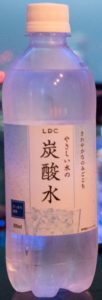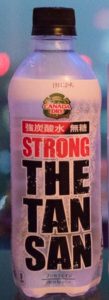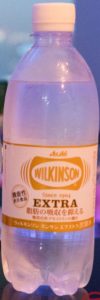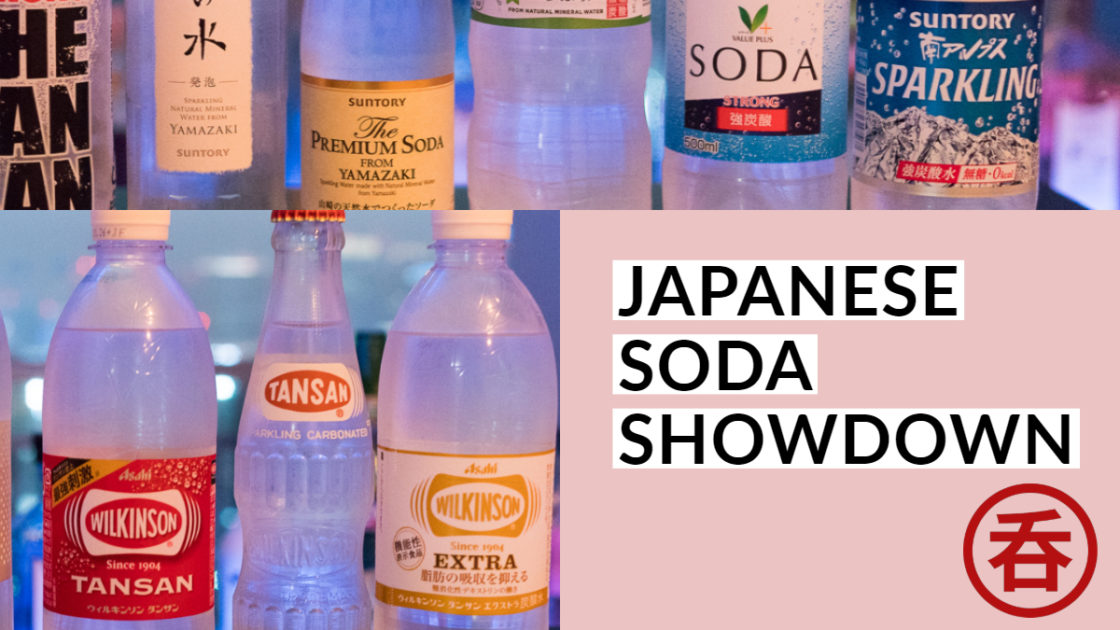As an island nation, water has been a big part of the culture in Japan since forever. It’s water that brings us many of the things we’ve come to love about Japan: amazing seafood, relaxing onsens, butt-spraying washlets, tasty rice, gnar pow, and great sake.
Soda. In part one of this water series we had plenty of different mineral waters from a wide variety of places in Japan. That’s fine and dandy, but I’d argue that soda water is actually playing a much bigger role in the Japanese whisky scene today. That’s because of one drink: the whisky highball.
After all, the Kaku Highball is largely responsible for the resurgence of Japanese whisky we’re seeing today. Without the success of the highball, it’s very likely that domestic demand for Japanese whisky would not have taken off like it has. In fact, so many highballs are sold in Japan that Suntory has to import whisky specifically for the purpose. The company has tried to replicate the success of the Kaku Highball outside of Japan with the Toki Highball. While Suntory may not sell as much Toki as they’d like, the drink itself has been successful enough that many leading bars throughout the world now feature some sort of Japanese-style highball riff.
Here in Japan, while there typically isn’t any departure from the standard recipe of whisky, soda, ice, and maybe lemon, you can try a couple different styles of highball. The Samboa-style highball, for instance, is an entirely different experience from a standard highball. If you’re feeling even more adventurous, put just a little bit of soda in your whisky to make a choiso.
But not all sodas are created equal! It goes without saying that the kind of soda water you choose for your highball ought to make a big difference.
The Methodology
As we mentioned in the still water showdown. There are only two steps for each evaluation:
- Try the water on its own.
- Try the water with whisky.
Japanese Water Showdown: SODA Edition
There are so so many sodas available in Japan these days that it’s impossible to cover all of them. I have tried to focus on the major, regularly available sodas that are made here in Japan.
Worth noting here that the Japanese language doesn’t make any distinction between seltzer water, soda water, club soda, natural sparkling spring water, or any of the other things we have in English. It’s all simply “soda” in Japan. As such, I use the terms “sparkling water” and “soda” interchangeably below.
Entry #1: SEVEN&i Strong SPARKLING WATER
 Hit up any Seven-11 in Tokyo and this is the soda you’ll find there. Important because if you’re the kind of person that wants to mix your own highball as a roadie, this is the soda you’ll be using.
Hit up any Seven-11 in Tokyo and this is the soda you’ll find there. Important because if you’re the kind of person that wants to mix your own highball as a roadie, this is the soda you’ll be using.
At the beginning it’s quite sharp, with a very noticeable strong carbonation. Taste-wise though it’s very neutral and low-key, so a mighty fine effort by Seven-11 here.
Entry #2: LDC Soda
 This one is by “LifeDrink Company,” and was available down at my local liquor store. 51 yen makes it the cheapest bottled soda I know. This ended up being one of my personal favorites of this showdown. The bubbles here are extremely fine. This helped bring out some of the sweeter notes of the Nikka FTB. That’s definitely a positive for me! However, those finer bubbles mean the carbonation doesn’t last long.
This one is by “LifeDrink Company,” and was available down at my local liquor store. 51 yen makes it the cheapest bottled soda I know. This ended up being one of my personal favorites of this showdown. The bubbles here are extremely fine. This helped bring out some of the sweeter notes of the Nikka FTB. That’s definitely a positive for me! However, those finer bubbles mean the carbonation doesn’t last long.
Entry #3: ValuePlus Soda Strong
 This comes from my local grocery store. This ValuePlus soda costs a mere 75 yen! It has a medium amount of carbonation — not strong — but did bring forth some of the fruitier flavors of the whisky. At the same time it seemed to muffle some of the whisky’s sharpness, making things more flat overall.
This comes from my local grocery store. This ValuePlus soda costs a mere 75 yen! It has a medium amount of carbonation — not strong — but did bring forth some of the fruitier flavors of the whisky. At the same time it seemed to muffle some of the whisky’s sharpness, making things more flat overall.
Entry #4: Sparkling Irohasu
 As we mentioned in the still showdown, Irohasu is Japan’s best-selling water in the under-600ml size. So of course Coca-Cola also offers a carbonated version of the stuff.
As we mentioned in the still showdown, Irohasu is Japan’s best-selling water in the under-600ml size. So of course Coca-Cola also offers a carbonated version of the stuff.
This is by far the longest lasting carbonation of these first few sodas. There are some hints of fruitiness in the whisky brought forth by it, alongside plenty of dryness and woody oak. Excellent!
Entry #5: STRONG The Tansan
 Okay, okay, I know I said I would focus on Japanese-made sodas, and this one is actually sold under the Canada Dry brand by Coca-Cola. I doubt it’s actually made in Canada though, given it’s the cheapest of all these sodas at only 69 yen per bottle. What’s it like? “Tansan” is Japanese for carbonation, by the way.
Okay, okay, I know I said I would focus on Japanese-made sodas, and this one is actually sold under the Canada Dry brand by Coca-Cola. I doubt it’s actually made in Canada though, given it’s the cheapest of all these sodas at only 69 yen per bottle. What’s it like? “Tansan” is Japanese for carbonation, by the way.
Well, it’s damn strong! Definitely the hardest of the lot so far. It brought out some of the harder, rougher edges of the whisky. Perhaps this one takes the carbonation a bit too far for me.
Entry #6: Wilkinson Tansan (PET bottle)
 Wilkinson Tansan is Japan’s first brand of bottled sparkling mineral water. The company was created back in 1905 by John Clifford Wilkinson–yes, an Englishman–who apparently stumbled upon a spring of aerated water while hunting down near Kobe. He didn’t name the brand “Wilkinson Soda” though: it’s been called Tansan since day one, even when he went on to sell the water in English-speaking countries like American-occupied Philippines.
Wilkinson Tansan is Japan’s first brand of bottled sparkling mineral water. The company was created back in 1905 by John Clifford Wilkinson–yes, an Englishman–who apparently stumbled upon a spring of aerated water while hunting down near Kobe. He didn’t name the brand “Wilkinson Soda” though: it’s been called Tansan since day one, even when he went on to sell the water in English-speaking countries like American-occupied Philippines.
The brand stuck. Asahi acquired the rights to the name in 1983, and today Wilkinson remains Japan’s de-facto sparkling water.
And yes, it’s one of the few on this list that is a naturally sparkling water — the others have their carbonation added later.
Wilkinson Tansan is available pretty much everywhere, but the average consumer knows it as coming from a PET bottle. So let’s start with that!
I found the PET bottle Tansan to be very neutral, neither adding nor taking anything away flavor-wise. If my preferred level of carbonation is 7 out of 10 though, Tansan here is perhaps a 5 or 6. Which is to say, just a hint too weak for my tastes.
Entry #7: Wilkinson Tansan (Glass bottle)
 Wilkinson Tansan also comes in glass bottles. In Tokyo, 99% of the time you order a highball at a proper cocktail bar, you’ll get one using Wilkinson Tansan from a glass bottle.
Wilkinson Tansan also comes in glass bottles. In Tokyo, 99% of the time you order a highball at a proper cocktail bar, you’ll get one using Wilkinson Tansan from a glass bottle.
Being primarily used by bartenders, the glass bottle Tansan usually isn’t sold in grocery stores or combinis. But your local liquor store in Tokyo probably has it. Mine charges 84 yen, which might sound mid-range, but the bottle is only 190ml. That’s basically the same cost as the above PET bottle, which contains 500ml.
Anyone who has ever had a Coke out of glass bottle knows that packaging alone can make a difference for a soda. Let’s see if that’s also the case with Wilkinson Tansan.
In fact, it turns out the container does help Tansan here get right at that level 7 of carbonation that I like. It’s still neutral flavor-wise, but it’s noticeably stronger than the plastic bottle. Score for glass!
Entry #8: Wilkinson Tansan EXTRA
 Of course Wilkinson soda has flavored versions out there, but EXTRA here is unflavored. What makes it EXTRA? It contains indigestible dextrin, qualifying it as a Food with a Functional Claim. The dextrin is supposed to not taste like anything, but let’s put that to the taste test.
Of course Wilkinson soda has flavored versions out there, but EXTRA here is unflavored. What makes it EXTRA? It contains indigestible dextrin, qualifying it as a Food with a Functional Claim. The dextrin is supposed to not taste like anything, but let’s put that to the taste test.
I don’t know anything about dextrin, but if that’s seriously the only difference between this and regular Tansan, I suppose that makes me an anti-dextrin-highball guy. It make my whisky noticeably flatter and more boring. Blah.
Entry #9: Minami Alps Sparkling
 This is Suntory’s entry-level soda. If you get a highball during your tour of Suntory’s Hakushu or Yamazaki Distilleries, this is the bottle of soda you get. Like the still water version, it’s also made at Suntory’s Hakushu bottling plant. Of course that Hakushu mineral water is not carbonated to begin with — it’s added here.
This is Suntory’s entry-level soda. If you get a highball during your tour of Suntory’s Hakushu or Yamazaki Distilleries, this is the bottle of soda you get. Like the still water version, it’s also made at Suntory’s Hakushu bottling plant. Of course that Hakushu mineral water is not carbonated to begin with — it’s added here.
I found the Minami Alps Sparkling soda to be lacking the necessary bite that I want out of a highball. Flavor-wise there isn’t anything worth noting here — very neutral!
Entry #10: The Premium Soda from Yamazaki
 The next level up in Suntory’s offerings is The Premium Soda from Yamazaki. As the name indicates, it’s made using the same water source as the crowd favorite Japanese whisky.
The next level up in Suntory’s offerings is The Premium Soda from Yamazaki. As the name indicates, it’s made using the same water source as the crowd favorite Japanese whisky.
If I had to name a non-Japanese soda that this is closest to, I’ll say Pellegrino. The bubbles were very fine, often the sign of some luxury sodas, but not something I am personally looking for.
Entry #11: Yamazaki no Mizu
 This is an ultra-premium soda made by Suntory, also from the same water source that’s used by the Yamazaki Distillery. Why are there two? No idea! But unlike the previous entry, Yamazaki no Mizu here is not sold directly to consumers: you won’t find it at grocery stores in combinis. Instead, it’s targeted at bartenders. I was able to find a bottle at a liquor store in Ginza,
This is an ultra-premium soda made by Suntory, also from the same water source that’s used by the Yamazaki Distillery. Why are there two? No idea! But unlike the previous entry, Yamazaki no Mizu here is not sold directly to consumers: you won’t find it at grocery stores in combinis. Instead, it’s targeted at bartenders. I was able to find a bottle at a liquor store in Ginza,
Yamazaki no Mizu is actually available with two different levels of carbonation: 1.8kg/sqcm, or 3.0kg/sqcm. I chose the latter.
At 300 yen, it’s the most expensive of the lot. Is it worth it?
In a word: absolutely. This is made by far the best highball on this list. Definitely highlights the whisky flavors while providing a solid base of carbonation that definitely reminds you you’re drinking a highball.
And the winnerS Are…
Taste: Looking at things purely from the perspective of “yeah, that makes a damn good highball,” I will have to title the award to entry #11, Yamazaki no Mizu. The balance of sharpness of the carbonation was at a level I really look for in a highball — high enough to give a slight stinging sharpness, but not so high that it overpowers the whisky itself. As a runner-up not far behind at all comes entry #7, glass bottle Tansan, the true classic Japanese soda water.
Unfortunately neither Yamazaki no Mizu nor Tansan in glass bottles are sold at any old combini or grocery store.
Price/availability: So if we take into consideration those two factors alongside taste, entry #4 Irohasu Sparkling is the clear, sparkling winner. It’s available widely enough, it’s affordable, and it still contributes quite a lot to a fantastic highball.
Hi there! I created and run nomunication.jp. I’ve lived in Tokyo since 2008, and I am a certified Shochu Kikisake-shi/Shochu Sommelier (焼酎唎酒師), Cocktail Professor (カクテル検定1級), and I hold Whisky Kentei Levels 3 and JW (ウイスキー検定3級・JW級). I also sit on the Executive Committees for the Tokyo Whisky & Spirits Competition and Japanese Whisky Day. Click here for more details about me and this site. Kampai!

